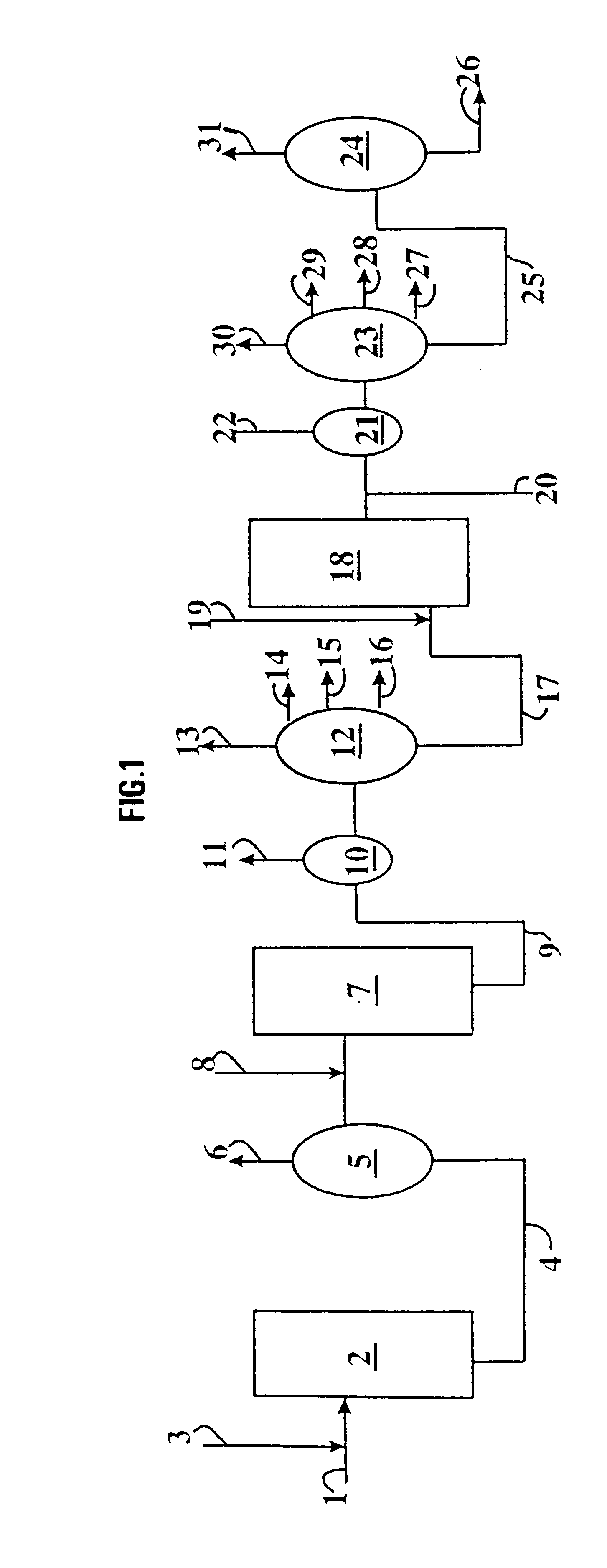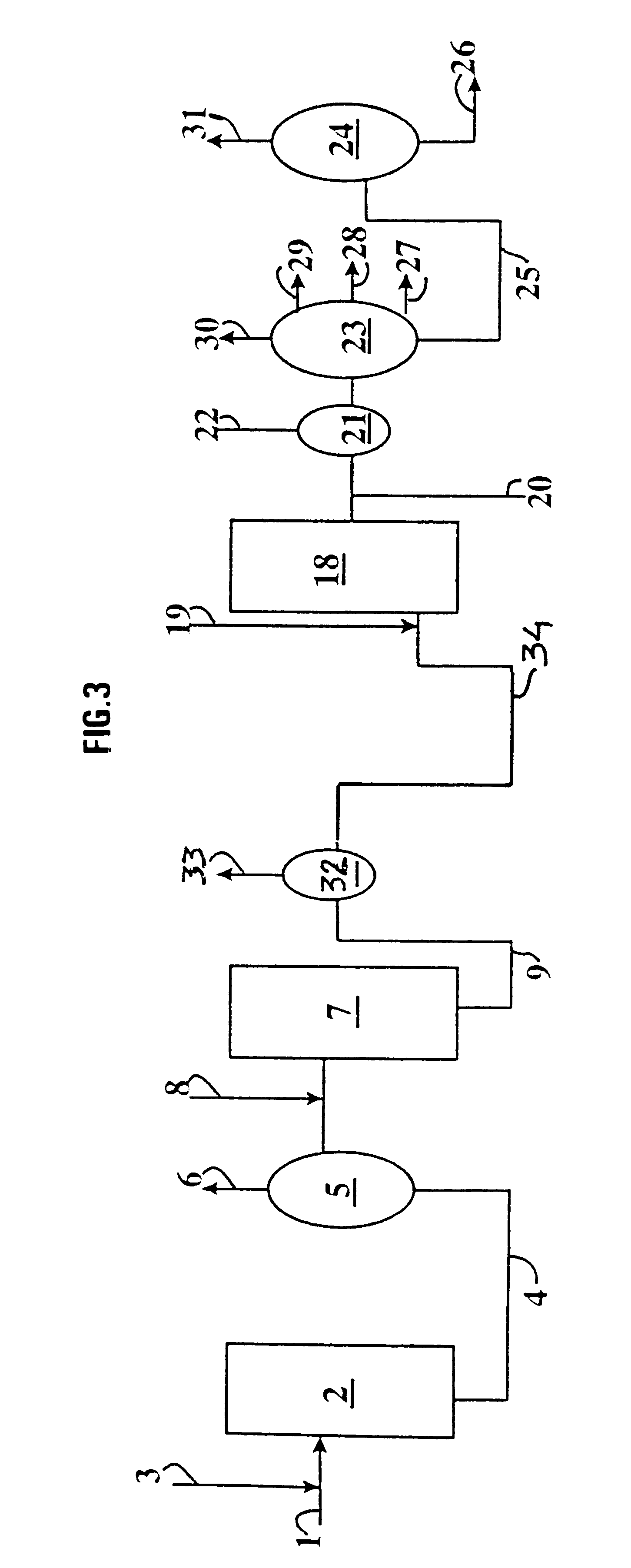Flexible process for producing base stock and distillates by conversion-hydroisomerisation using a catalyst with low dispersion followed by catalytic dewaxing
a technology of conversion hydroisomerisation and catalytic dewaxing, which is applied in the direction of physical/chemical process catalysts, metal/metal-oxide/metal-hydroxide catalysts, naphtha treatment, etc., can solve the problem of high pour poin
- Summary
- Abstract
- Description
- Claims
- Application Information
AI Technical Summary
Benefits of technology
Problems solved by technology
Method used
Image
Examples
example 2
Evaluation of Catalyst A1 for Hydroisomerisation of a Fischer-Tropsch feed Followed by Separation and Catalytic Dewaxing
The catalyst prepared as described in Example 1 was used to hydroisomerise a paraffin feed from the Fischer-Tropsch synthesis with the principal aim of producing oils. In order to be able to directly use the hydroisomerisation catalyst, the feed was first hydrotreated and the oxygen content brought to below 0.1% by weight. The principal characteristics of the hydrotreated feed were as follows:
The catalytic test unit comprised a single fixed bed reactor used in up-flow mode, into which 80 ml of catalyst was introduced. The catalyst was then placed under a pure hydrogen atmosphere at a pressure of 10 MPa to reduce the platinum oxide to metallic platinum, then finally the feed was injected. The total pressure was 10 MPa; the hydrogen flow rate was 1000 liters of gaseous hydrogen per liter of injected feed; the hourly space velocity was 2 h.sup.-1 ; and the reaction te...
example 3
Evaluation of Catalyst A1 During a Test Carried out to Produce Middle Distillates
The same procedure as that described for Example 2 was used, with the same feed, but the operating conditions in the first reactor containing catalyst A1 were modified.
The total pressure was 9 MPa; the hydrogen flow rate was 1000 liters of gaseous hydrogen per liter of injected feed, the hourly space velocity was 1 h.sup.-1 and the reaction temperature was 355.degree. C. After reacting, the effluents were fractionated into light products (gasoline, IP-150.degree. C.), kerosine (150-250.degree. C.), gas oil (250-380.degree. C.) and residue (380.sup.+).
The yields and characteristics are reported below for the different fractions of the hydroisomerised effluents using catalyst A1.
Quality of Distillate Products:
Catalyst A1 could produce good middle distillate yields (weight fraction 150-250.degree. C. + weight fraction 250-380.degree. C.=72% by weight) from a paraffin feed from the Fischer-Tropsch process a...
example 4
The hydrocracking residue with the characteristics given in the table below was introduced into a reactor containing a fixed bed of hydroisomerisation-conversion catalyst A2 and hydrogen at a total pressure of 12 mPa and in a H.sub.2 / HC volume ratio of 1000 N1 / N1. The space velocity was thus 1 h.sup.-1 for the catalyst. The reaction temperature was 340.degree. C.
Catalyst A2 contained a support containing 28% by weight of SiO.sub.2 and 72% by weight of Al.sub.2 O.sub.3 on which 0.5% by weight of Pt had been deposited. The Pt dispersion was 15%.
The effluent was recovered then vacuum distilled to recover a 380.degree. C..sup.+ fraction with the characteristics shown in the table below.
The 250-380.degree. C. fraction which corresponded to a gas oil cut and which resulted from converting hydroisomerisation of a hydrocracking residue had a pour point of -20.degree. C. and a cetane index of 57, which produced an excellent gas oil.
The 380.degree. C.+ fraction prepared above was then introd...
PUM
| Property | Measurement | Unit |
|---|---|---|
| pressure | aaaaa | aaaaa |
| temperature | aaaaa | aaaaa |
| pressure | aaaaa | aaaaa |
Abstract
Description
Claims
Application Information
 Login to View More
Login to View More - R&D
- Intellectual Property
- Life Sciences
- Materials
- Tech Scout
- Unparalleled Data Quality
- Higher Quality Content
- 60% Fewer Hallucinations
Browse by: Latest US Patents, China's latest patents, Technical Efficacy Thesaurus, Application Domain, Technology Topic, Popular Technical Reports.
© 2025 PatSnap. All rights reserved.Legal|Privacy policy|Modern Slavery Act Transparency Statement|Sitemap|About US| Contact US: help@patsnap.com



